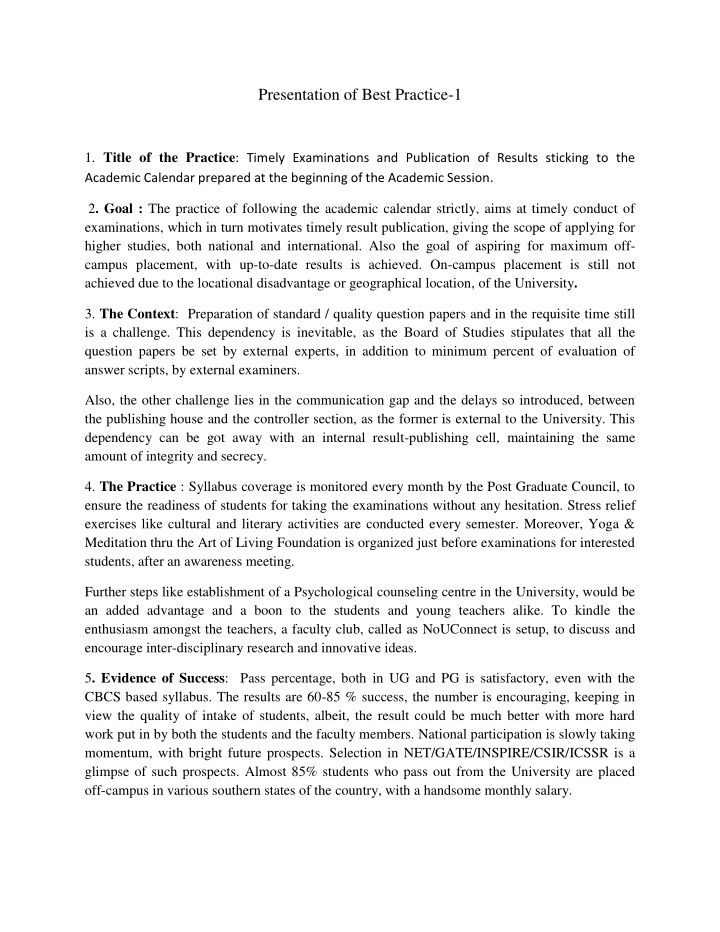



Presentation of Best Practice-1 1. Title of the Practice : Timely Examinations and Publication of Results sticking to the Academic Calendar prepared at the beginning of the Academic Session. 2 . Goal : The practice of following the academic calendar strictly, aims at timely conduct of examinations, which in turn motivates timely result publication, giving the scope of applying for higher studies, both national and international. Also the goal of aspiring for maximum off- campus placement, with up-to-date results is achieved. On-campus placement is still not achieved due to the locational disadvantage or geographical location, of the University . 3. The Context : Preparation of standard / quality question papers and in the requisite time still is a challenge. This dependency is inevitable, as the Board of Studies stipulates that all the question papers be set by external experts, in addition to minimum percent of evaluation of answer scripts, by external examiners. Also, the other challenge lies in the communication gap and the delays so introduced, between the publishing house and the controller section, as the former is external to the University. This dependency can be got away with an internal result-publishing cell, maintaining the same amount of integrity and secrecy. 4. The Practice : Syllabus coverage is monitored every month by the Post Graduate Council, to ensure the readiness of students for taking the examinations without any hesitation. Stress relief exercises like cultural and literary activities are conducted every semester. Moreover, Yoga & Meditation thru the Art of Living Foundation is organized just before examinations for interested students, after an awareness meeting. Further steps like establishment of a Psychological counseling centre in the University, would be an added advantage and a boon to the students and young teachers alike. To kindle the enthusiasm amongst the teachers, a faculty club, called as NoUConnect is setup, to discuss and encourage inter-disciplinary research and innovative ideas. 5 . Evidence of Success : Pass percentage, both in UG and PG is satisfactory, even with the CBCS based syllabus. The results are 60-85 % success, the number is encouraging, keeping in view the quality of intake of students, albeit, the result could be much better with more hard work put in by both the students and the faculty members. National participation is slowly taking momentum, with bright future prospects. Selection in NET/GATE/INSPIRE/CSIR/ICSSR is a glimpse of such prospects. Almost 85% students who pass out from the University are placed off-campus in various southern states of the country, with a handsome monthly salary.
6. Problems Encountered and Resources Required : Due to the large number of affiliated colleges under the University, managing UG examinations has become a herculean task for the examination. Moreover, CBCS syllabus introduced the extra cost of conducting Internal Assessment Examination (IAE) on a mid-term basis and collecting them, inaddition to end- semester examination. An online system of storing IAE marks by the Colleges independently, would reduce the load on the University. In addition, complete automation is the solution to heavily loaded confidential work of the examination cell. A common portal for the same would be a boon. Presentation of Best Practice-2 1. Title of the Practice: Maintaining Green Cover in the University Premises 2. Goal: To keep the academic and administrative environment of the University clean and fresh, free of pollutants like dust and smoke. Regular Afforestation programmes, planting trees on various occasions and Swachhta drives often are the practices followed by the University and its affiliated and constituent colleges. The 162 NSS units of the University under the strong Bureau is the backbone behind achievement of this goal. 3. The Context : Coordination and collaboration with the Forest Department through the liaisoning officer, procurement or purchase of saplings, flowering plants, seeds, manure is a major part of this plan. Maintenance and providing regular water and protection to the growing plants is the other challenge. The University believes in the policy of no-cutting-of – trees, to keep the forest cover around the University, intact. 4. The Practice: The culture of gifting saplings to guests on various occasions instead of flower bouquets has started, thus making it an eco-friendly practice. Conduct of cycle rally to spread awareness about vehicular emission and its ill-effects has been organized in collaboration with an NGO. An effective Waste management policy is followed, to consciously dispose off the waste generated in various laboratories, like physical, biological, radio-active, chemical and e- waste and other sections of the University, akin to that of the Odisha Pollution Control Board.
Ignorance about the presence of a Collection Centre in the vicinity is a challenge to the University , to carry out effectively, its waste disposal policy. 5. Evidence of Success: The above practices have been proved effective and advantageous and the University campus is till now, free from major pollutants, due to the simple reason that all the stakeholder shave chosen to abide by the policy. Each faculty and student is encouraged to plant and own a single plant. The peer team which visited the University during 2017, had appreciated the green cover in the surrounding of the university. 6. Problems Encountered and Resources Required: Strict enforcement of No-Plastic would help us achieve the goal much faster and easier. Forest fire raging during hot months is a perennial problem in the region. Monitoring and vigilance of the plantation area is an extra cost for the University; if the forest department can take over the responsibility, it would be a relief. Use of bio-degradable paper plates / Leaf dona, mud cups for tea etc are some of the practices, requiring funds and resources to be made and used locally inside the University. Skill based training / MSME camps are some motivators in such direction in future.
Recommend
More recommend